2014 年 6 月英语四级真题(第二套)
Part I
Writing
(30 minutes)
Directions: Forthispart,youareallowed30minutestowriteashortessayonthe
followingquestion.Youshouldwriteatleast120wordsbutNomorethan
180 words.
Suppose a foreign friend of yours is coming to visit your campus, what is the
most interesting place you would like to take him/her to see and why?
Part Ⅱ
Section A
Listening Comprehension
(30 minutes)
Directions: In this section, you will hear 8 short conversations and 2 long
conversations. At the end of each conversation, one or more questions
willbeaskedaboutwhatwassaid.Boththeconversationandthequestions
will be spoken only once. After each question there will be a pause.
During the pause, youmustread thefour choicesmarked A), B), C) and
D), and decide which is the best answer. Then mark the corresponding
letter on Answer Sheet I with a single line through the centre.
1. A. They came in five different colors.
B. They were good value for money.
C. They were a very good design.
D. They were sold out very quickly.
2. A. Ask her roommate not to speak loudly on the phone.
B. Ask her roommate to make her phone calls outside.
C. Go and find a quieter place to review her lessons.
D. Report her problem to the dorm management.
3. A. The washing machine is totally beyond repair.
B. He will help Wendy prepare her annual report.
C. Wendy should give priority to writing her report.
D. The washing machine should be checked annually.
4. A. The man fell down when removing the painting.
B. The wall will be decorated with a new painting.
C. The woman likes the painting on the wall.
D. The painting is now being reframed.
�
5. A. It must be missing.
B. It was left in the room.
C. The man took it to the market.
D. She placed it on the dressing table.
6. A. Go to a play.
B. Meet Janet.
C. Book some tickets.
D. Have a get-together.
7. A. One box of books is found missing.
B. Some of the boxes arrived too late.
C. Replacements have to be ordered.
D. Some of the books are damaged.
8. A. The man will pick up Professor Johnson at her office.
B. The man did not expect Iris paper to be graded too soon.
C. Professor Johnson has given the man a very high grade.
D. Professor Johnson will talk to each student in her office.
Questions 9 to 11 are based on the conversation you have just heard.
9. A. To buy a present for his friend who is getting married.
B. To find out the cost for a complete set of cookware.
C. To see what he could ask his friends to buy for him.
D. To make inquiries about the price of an electric cooker.
10. A. To teach him how to use the kitchenware.
B. To discuss cooking experiences with him.
C. To tell him how to prepare delicious dishes.
D. To recommend suitable kitchenware to him.
11. A. There are so many different sorts of knives.
B. Cooking devices are such practical presents.
C. A mixer can save so much time in making cakes.
D. Saucepans and frying pans are a must in the kitchen.
Questions 12 to 15 are based on the conversation you have just heard.
12. A. Some new problems in her work.
B. Cooperation with an international bank.
C. Her chance for promotion in the bank.
D. Her intention to leave her present job.
13. A. The World Bank.
�
B. Bank of Washington.
C. A U.S. finance corporation.
D. An investment bank in New York.
14. A. Supervising financial transactions.
B. Taking charge of public relations.
C. Making loans to private companies in developing countries.
D. Offering service to international companies in the United States.
15. A. It is a first major step to realizing the woman’s dream.
B. It is an honor for the woman and her present employer.
C. It is a loss for her current company.
D. It is really beyond his expectation.
Section B
Directions: In this section, you will hear 3 short passages. At the end of each
passage,youwillhearsomequestions.Boththepassageandthequestions
willbespokenonlyonce.Afteryouhearaquestion,youmustchoosethe
bestanswerfromthefourchoicesmarkedA),B),C)andD).Thenmarkthe
corresponding letter on Answer Sheet 1 with a single line through the
centre.
Passage One
Questions 16 to 18 are based on the passage you have just heard.
16. A. Carry out a thorough checkup.
B. Try to keep the gas tank full.
C. Keep extra gas in reserve.
D. Fill up the water tank.
17. A. Attempting to leave your car to seek help.
B. Opening a window a bit to let in fresh air.
C. Running the engine every now and then.
D. Keeping the heater on for a long time.
18. A. It exhausts you physically.
B. It makes you fall asleep easily.
C. It causes you to lose body heat.
D. It consumes too much oxygen.
Passage Two
Questions 19 to 21 are based on the passage you have just heard.
19. A. They are very generous in giving gifts.
�
B. They refuse gifts when doing business.
C. They regard gifts as a token of friendship.
D. They give gifts only on special occasions.
20. A. They enjoy giving gifts to other people.
B. They spend a lot of time choosing gifts.
C. They have to follow many specific rules.
D. They pay attention to the quality of gifts.
21. A. Gift-giving plays an important role in human relationships.
B. We must be aware of cultural differences in giving gifts.
C. We must learn how to give gifts before going abroad.
D. Reading extensively makes one a better gift-giver.
Passage Three
Questions 22 to 25 are based on the passage you have just heard.
22. A. It reflects American people’s view of French politics.
B. It is first published in Washington and then in Paris.
C. It explains American politics to the French public.
D. It is popular among French government officials.
23. A. Work on her column.
B. Do housework at home.
C. Entertain her guests.
D. Go shopping downtown.
24. A. To report to her newspaper.
B. To refresh her French.
C. To visit her parents.
D. To meet her friends.
25. A. She might be recalled to France.
B. She might change her profession.
C. She might close her Monday column.
D. She might be assigned to a new post.
Section C
Directions: In this section, you will hear a passage three times. When the passage
is read for the first time, you should listen carefully for its general
idea. When the passage is read for the second time, you are required to
fill in the blanks with the exact words you have just hoard. Finally, when
�
the passage is read for the third time, you should check what you have
written.
According to American law, if someone is accused of a crime, he is considered
26
until the court proves the person is guilty.
To arrest a person, the police have to be reasonably sure that a crime has been
27 . The police must give the suspect the reasons why they are arresting him and
tell him his rights under the law. Then the police take the suspect to the police
station, where the name of the person and the 28
against him are formally listed.
The next step is for the suspect to go before a judge. The judge decides whether
the suspect should be kept in jail or
29 . If the suspect has no previous criminal
record and the judge feels that he will return to court
30
run away, he can go
free. Otherwise, the suspect must put up bail(保释金). At this time, too, the judge
will 31
a court lawyer to defend the suspect if he can’t afford one.
The suspect returns to court a week or two later. A lawyer from the district
attorney’s office presents a case against the suspect. The attorney may present
32
as well as witnesses. The judge then decides whether there is enough reason to
33 .
The American justice system is very complex and sometimes operates slowly.
However, every step is
34
to protect the rights of the people. These individual
rights are the
35
of the American government.
Part Ⅲ
Section A
Reading Comprehension
(40 minutes)
Directions: In this section, there isa passagewithten blanks.Youarerequired
toselectonewordforeachblankfromalistofchoicesgiveninaword
bank following the passage: Read the passage through carefully before
making yourchoices.Eachchoice inthebank isidentified bya letter.
PleasemarkthecorrespondingletterforeachitemonAnswerSheet2with
asinglelinethroughthecentre.Youmaynotuseanyofthewordsinthe
bank more than once.
Questions 36 to 45 are based on the following passage.
The fact is, the world has been finding less oil than it has been using for more
than twenty years now. Not only has demand been
36 , but the oil we have been finding
is coming from places that are
37
to reach. At the same time, more of this newly
38
oil is of the type that requires a greater investment to
39 . And because demand
for this precious resource will grow, according to some, by over 40 percent by 2025,
�
fueling the world’s economic
40
will take a lot more energy from every possible
source.
The energy industry needs to get more from existing fields while continuing to
search for new
41 . Automakers must continue to improve fuel efficiency and perfect
hybrid (混合动力的) vehicles. Technological improvements are needed so that wind,
solar and hydrogen can be more
42
parts of the energy equation. Governments need
to formulate energy policies that promote
43
and environmentally sound
development. Consumers must be willing to pay for some of these solutions, while
practicing conservation efforts of their own.
Inaction is not an
44 . So let’s work together to balance this equation. We
are taking some of the
45
needed to get started, but we need your help to go the
rest of the way.
A) consequently
B) cultivate
C) declining
D) derived
E) difficult
F) discovered
G) economically
H) exception
Section B
I) feasible
J) growth
K) Option
L) refine
M) reserves
N) soaring
O) steps
Directions: In this section, you are going to read a passage with ten statements
attachedtoit.Eachstatementcontainsinformationgiveninoneofthe
paragraphs.Identifytheparagraphfromwhichtheinformationisderived.
Youmaychooseaparagraphmorethanonce.Eachparagraphismarkedwith
a letter. Answer the questions by marking the corresponding letter on
Answer Sheet 2.
I Cry, Therefore I Am
[A] In 2008, at a German zoo, a gorilla (大猩猩) named Gana gave birth to a male
infant, who died after three months. Photographs of Gana, looking stricken and
inconsolable (伤心欲绝的), attracted crowds to the zoo. Sad as the scene was,
the humans, not Gana, were the only ones crying. The notion that animals can
weep has no scientific basis. Years of observations by biologists Dian Fossey,
who observed gorillas, and Jane Goodall, who worked with chimpanzees(黑猩猩),
could not prove that animals cry tears from emotion.
�
[B] It’s true that many animals shed tears, especially in response to pain. Tears
protect the eye by keeping it moist. But crying as an expression of feeling is
unique to humans and has played an essential role in human evolution and the
development of human cultures.
[C] Within two days an infant can imitate sad and happy faces. If an infant does
not cry out, it is unlikely to get the attention it needs to survive. Around 34
months, the relationship between the human infant and its environment takes on
a more organized communicative role, and tearful crying begins to serve
interpersonal purposes: the search for comfort and pacification (抚慰). As we
get older, crying becomes a tool of social interaction: grief and joy, shame and
pride, fear and manipulation.
[D] Tears are as universal as laughter, and grief is more complex than joy. But
although we all cry, we do so in different ways. Women cry more frequently and
intensely than men, especially when exposed to emotional events. Like crying,
depression is, around the world, more commonly seen in women than in men. One
explanation might be that women, who despite decades of social advances still
suffer from economic inequality, discrimination(歧视) and even violence, might
have more to cry about. Men not only cry for shorter periods than women, but
they also are less inclined to explain their tears, usually shed them more
quietly, and tend more frequently to apologize when they cry openly. Men, like
women, report crying at the death of a loved one and in response to a moving
religions experience. They are more likely than women to cry when their core
identities—as providers and protectors, as fathers and fighters—are
questioned.
[E] People who score on personality tests as more sympathetic cry more than those
who are more rigid or have more self-control. Frequency of crying varies widely:
some shed tears at any novel or movie, others only a handful of times in their
lives. Crying in response to stress and conflict in the home, or after emotional
trauma (创伤), lasts much longer than tears induced by everyday sadness—which
in turn last longer than tears of delight and joy.
[F] Sadness is our primary association with crying, but the fact is that people report
feeling happier after crying. Surveys estimate that 85% of women and 73% of men
report feeling better after shedding tears. Surprisingly, crying is more commonly
�
associated with minor forms of depression than with major depression involving
suicidal thoughts.
[G] People widely report that crying relieves tension, restores emotional balance
and provides “catharsis”, a washing out of bad feelings. The term
“catharsis” has religious implications of removing evil and sin; it’s no
surprise that religious ceremonies are, around the world, one of the main
settings for the release of tears.
[H] Crying is a nearly universal sign of grief, though some mourners report that,
despite genuine sorrow, they cannot shed tears—sometimes even for years after
their loved one has gone. Unlike today, when the privacy of grief is more
respected, the public or ceremonial shedding of tears, at the graveside of a
spouse or the funeral of a king or queen, was once considered socially or even
politically essential.
[I] Crying has also served other social purposes. Rousseau wrote in his Confessions
that while he considered tears the most powerful expression of love, he also just
liked to cry over nothing.
[J] The association of tears with art has ancient roots. The classic Greek tragedies
of the fifth century B.C. were primarily celebrations of gods. Tragedies, like
poetry and music, were staged religions events. Even then it was recognized that
crying in response to drama brought pleasure.
[K] I have argued that there are neurobiological (神经生物方面的) associations
linking the arts and mood disorders. When I lecture on crying, I ask my audience
to let me know, by a show of hands, which art forms most move them to tears.
About 80% say music, followed closely by novels (74%), but then the figures fall
sharply, to 43%, for poetry, and 10-22% for paintings, sculpture and
architecture.
[L] The physical act of crying is mainly one of breathing in air, which is why we
choke up when we weep. This suggests to language scientists that emotional crying
evolved before language, perhaps explaining why tears communicate states of mind
and feelings that are often so difficult to express in words. Of course, from
�

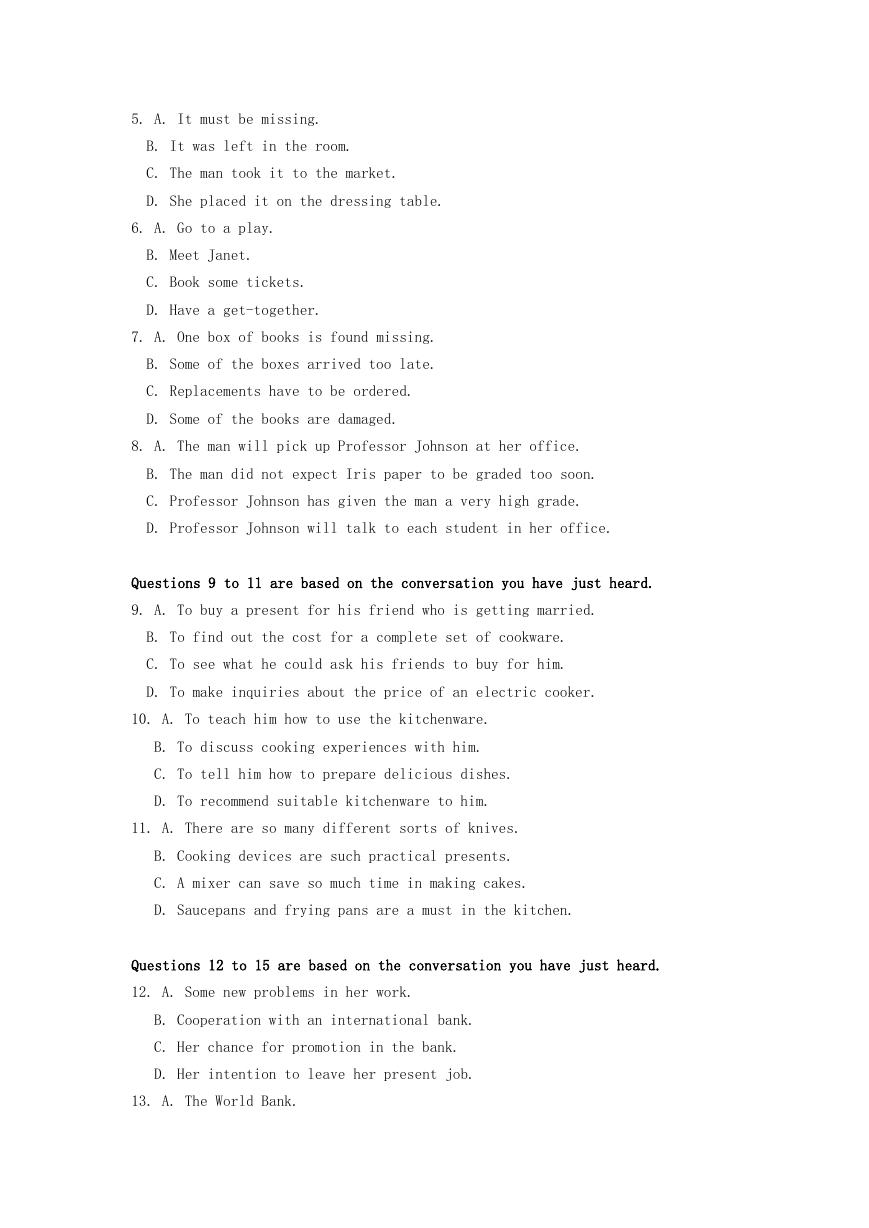
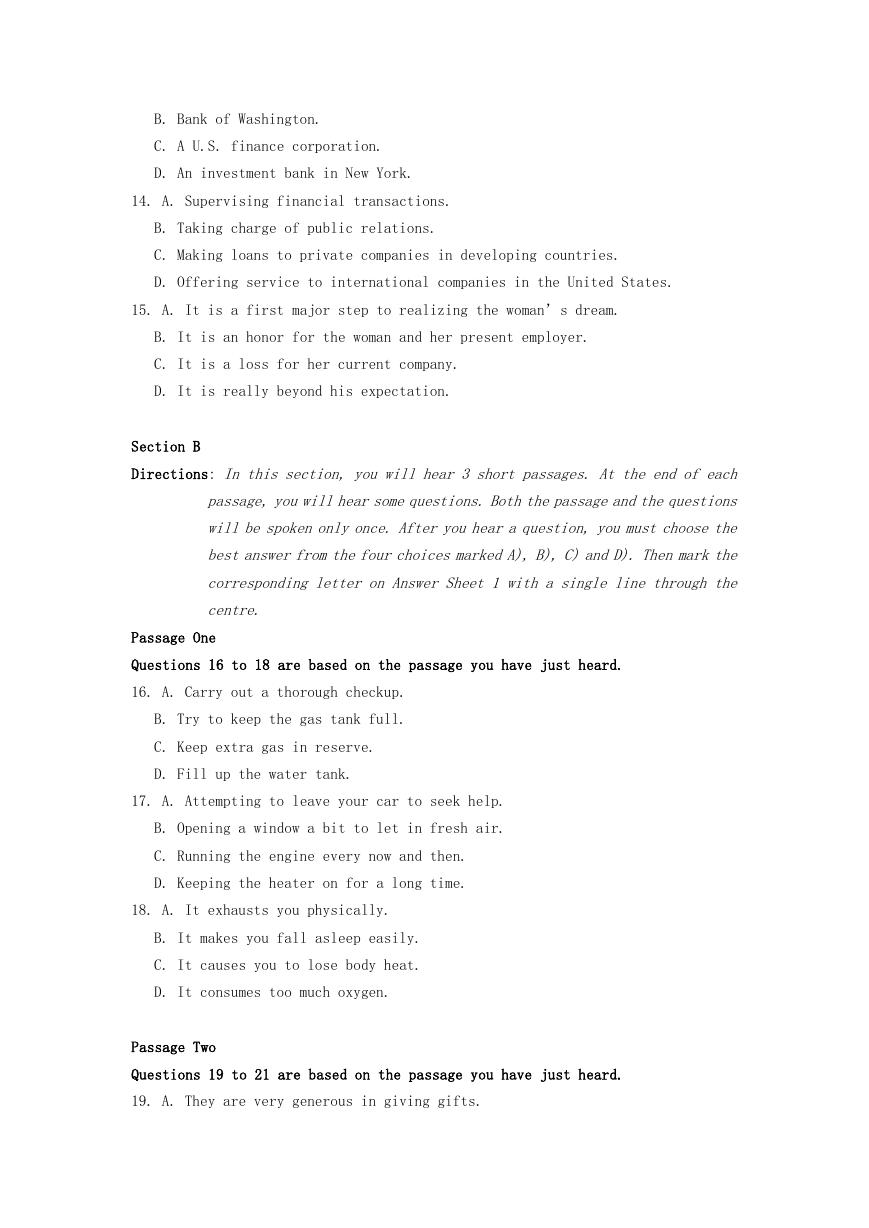
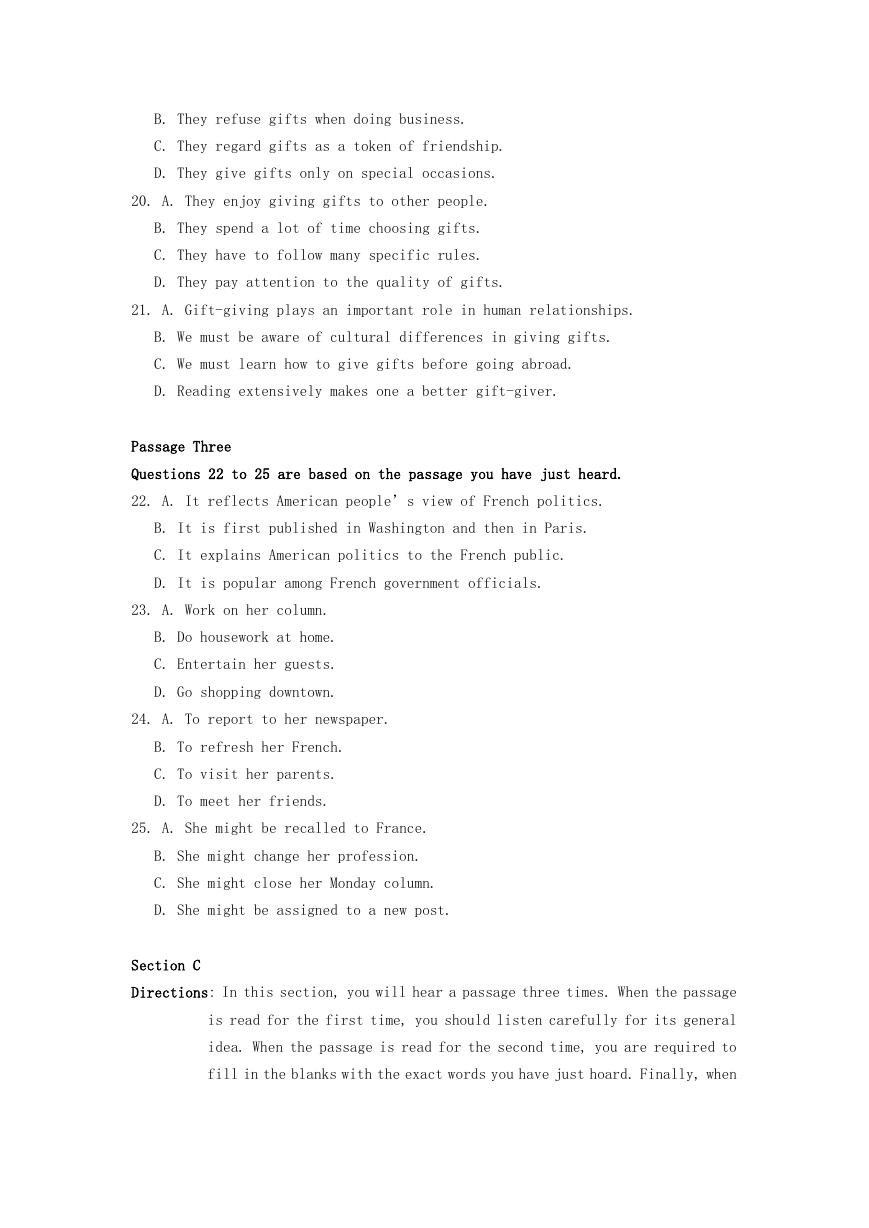
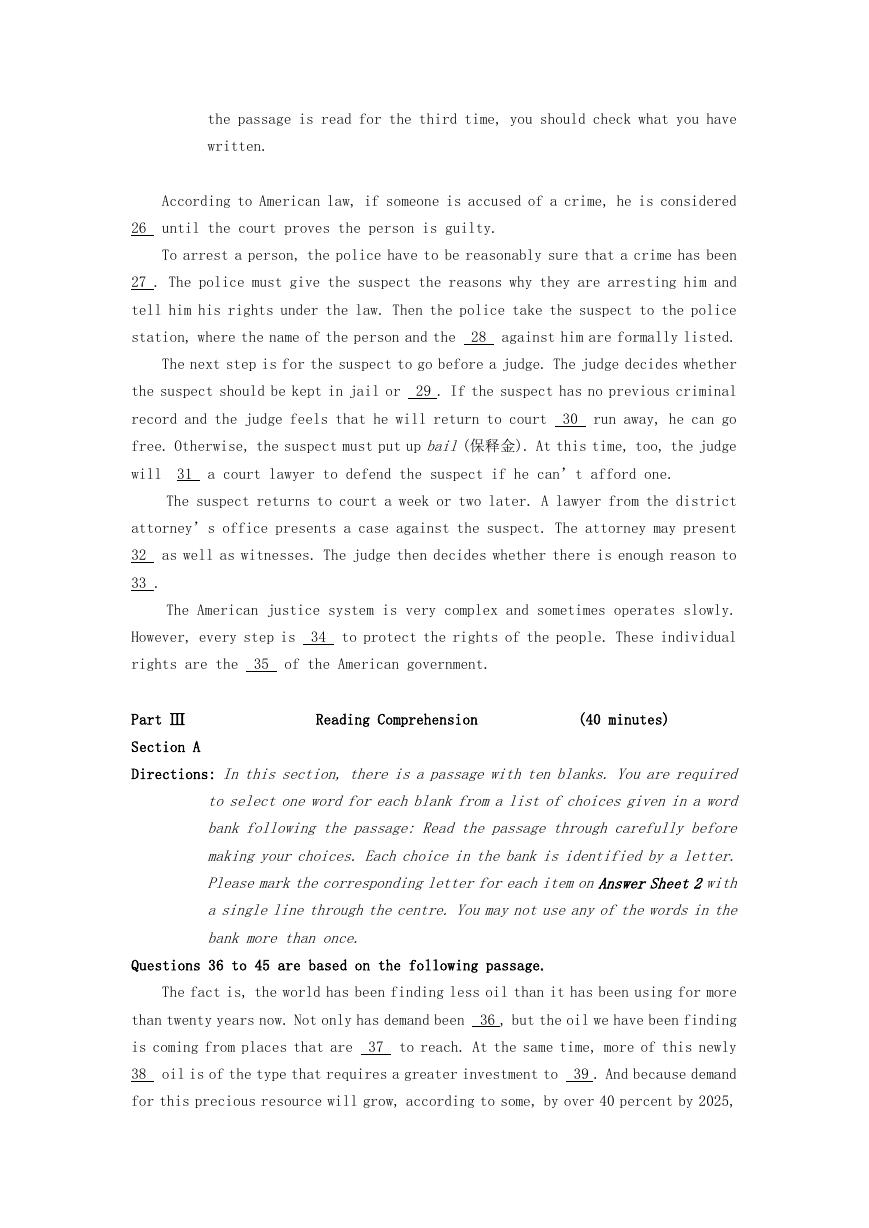
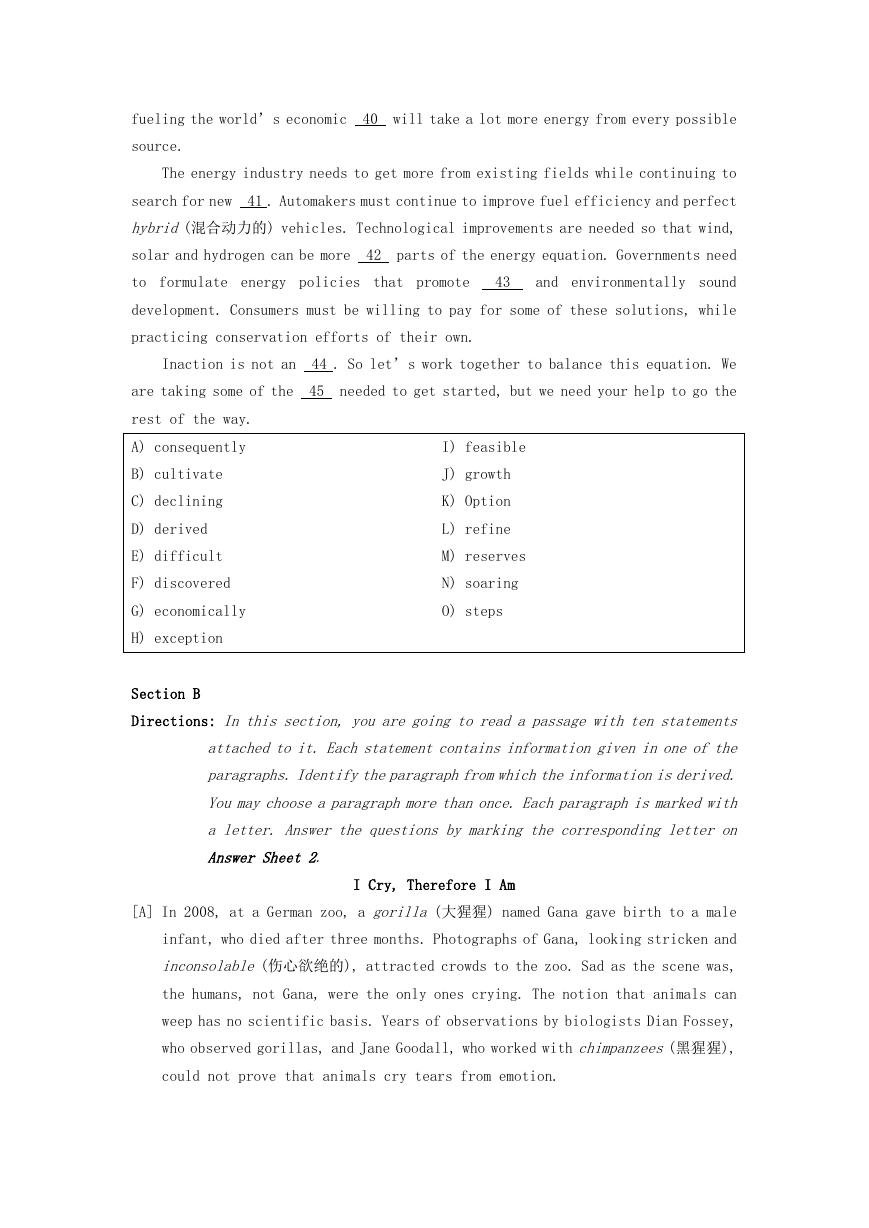
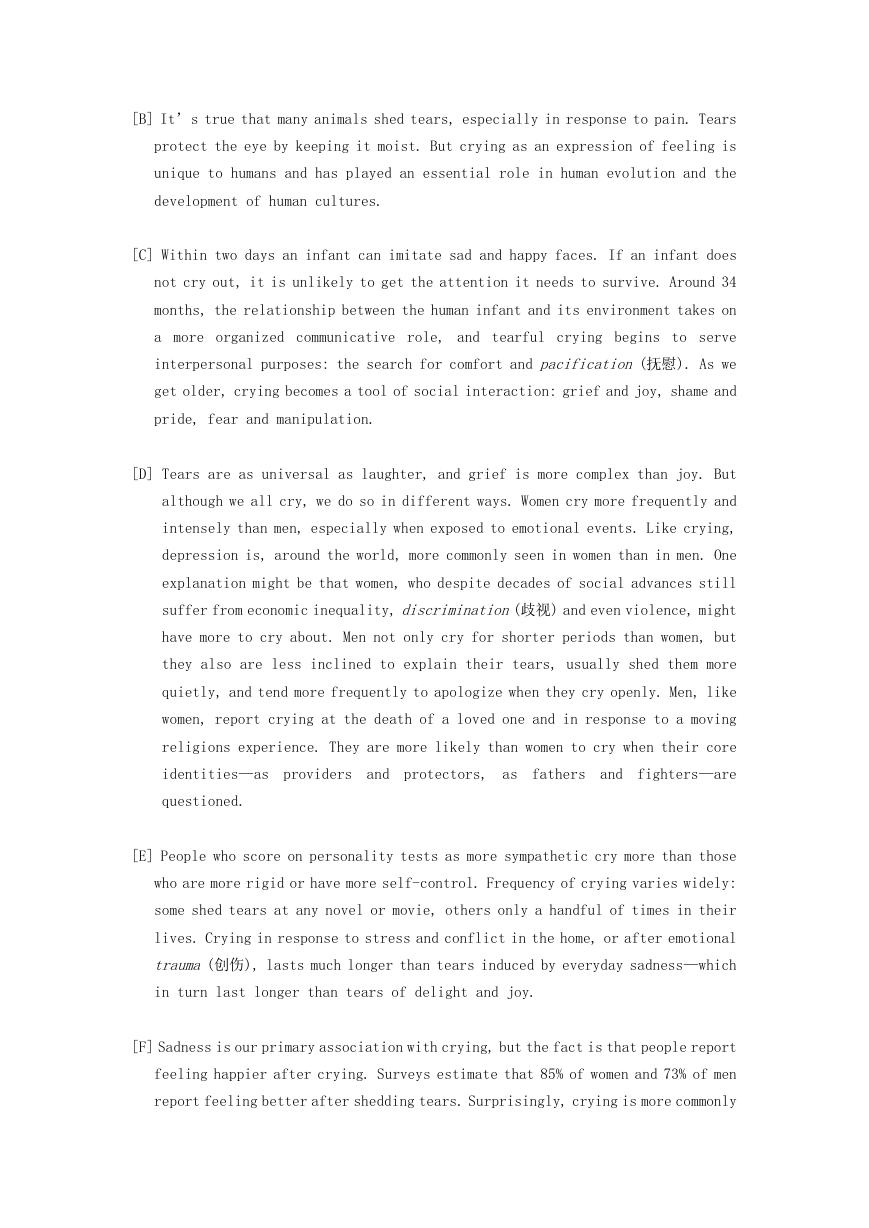









 2023年江西萍乡中考道德与法治真题及答案.doc
2023年江西萍乡中考道德与法治真题及答案.doc 2012年重庆南川中考生物真题及答案.doc
2012年重庆南川中考生物真题及答案.doc 2013年江西师范大学地理学综合及文艺理论基础考研真题.doc
2013年江西师范大学地理学综合及文艺理论基础考研真题.doc 2020年四川甘孜小升初语文真题及答案I卷.doc
2020年四川甘孜小升初语文真题及答案I卷.doc 2020年注册岩土工程师专业基础考试真题及答案.doc
2020年注册岩土工程师专业基础考试真题及答案.doc 2023-2024学年福建省厦门市九年级上学期数学月考试题及答案.doc
2023-2024学年福建省厦门市九年级上学期数学月考试题及答案.doc 2021-2022学年辽宁省沈阳市大东区九年级上学期语文期末试题及答案.doc
2021-2022学年辽宁省沈阳市大东区九年级上学期语文期末试题及答案.doc 2022-2023学年北京东城区初三第一学期物理期末试卷及答案.doc
2022-2023学年北京东城区初三第一学期物理期末试卷及答案.doc 2018上半年江西教师资格初中地理学科知识与教学能力真题及答案.doc
2018上半年江西教师资格初中地理学科知识与教学能力真题及答案.doc 2012年河北国家公务员申论考试真题及答案-省级.doc
2012年河北国家公务员申论考试真题及答案-省级.doc 2020-2021学年江苏省扬州市江都区邵樊片九年级上学期数学第一次质量检测试题及答案.doc
2020-2021学年江苏省扬州市江都区邵樊片九年级上学期数学第一次质量检测试题及答案.doc 2022下半年黑龙江教师资格证中学综合素质真题及答案.doc
2022下半年黑龙江教师资格证中学综合素质真题及答案.doc